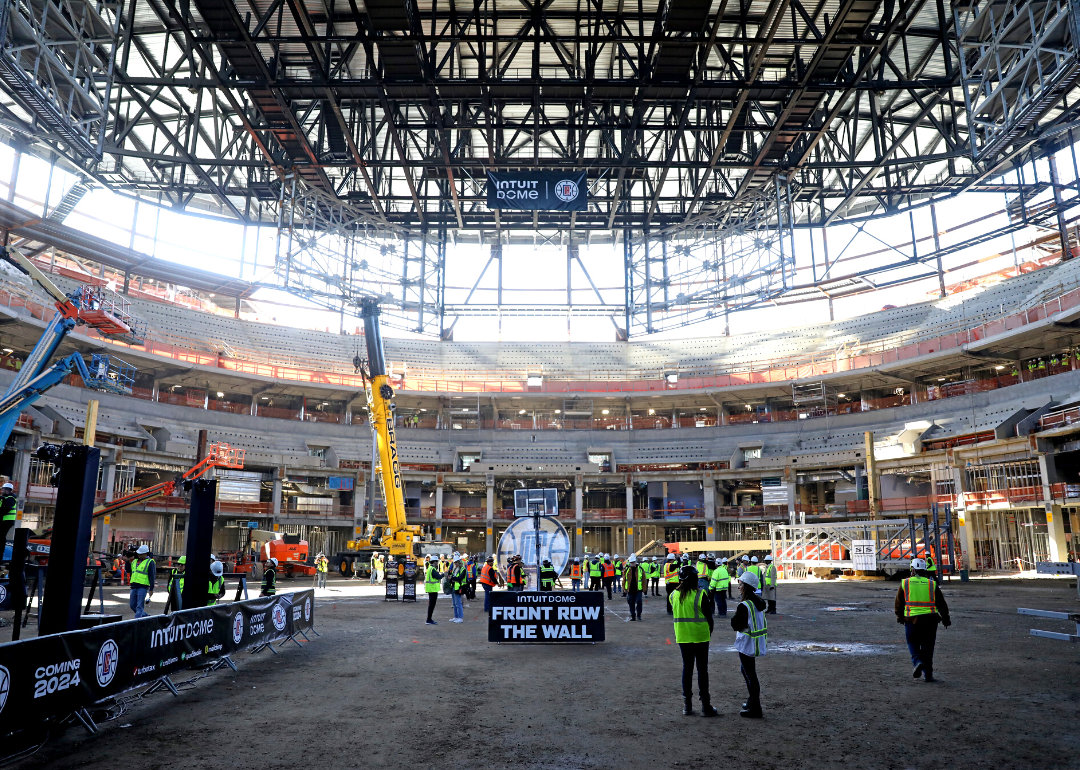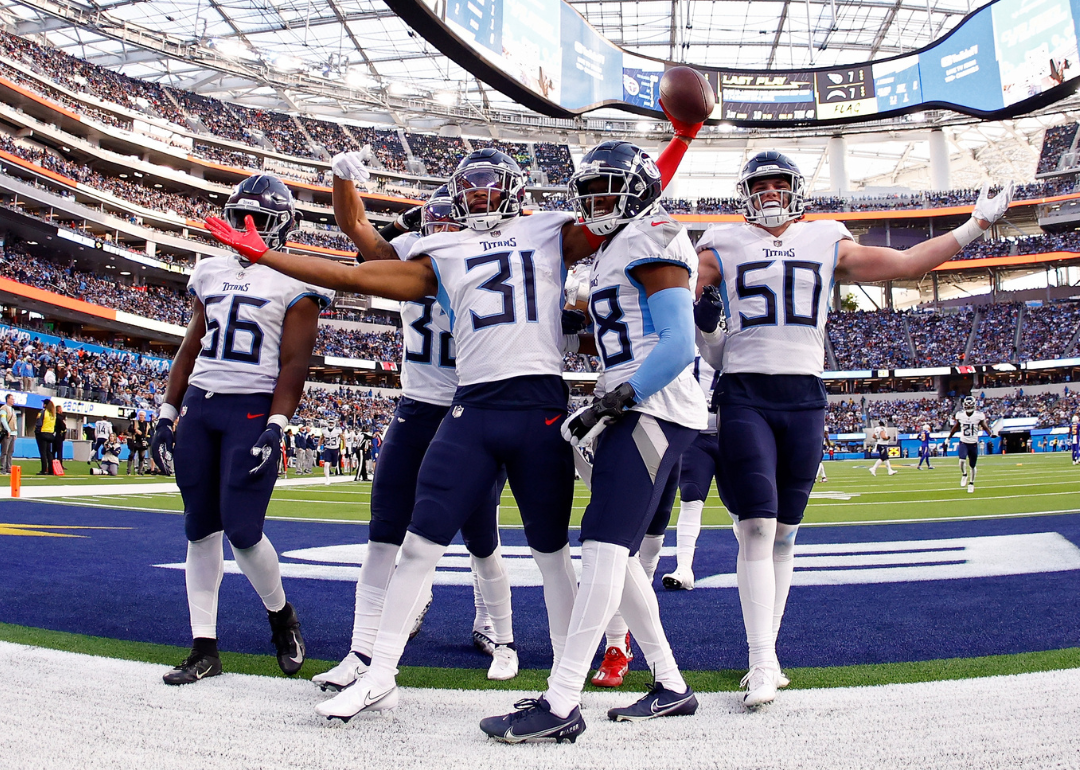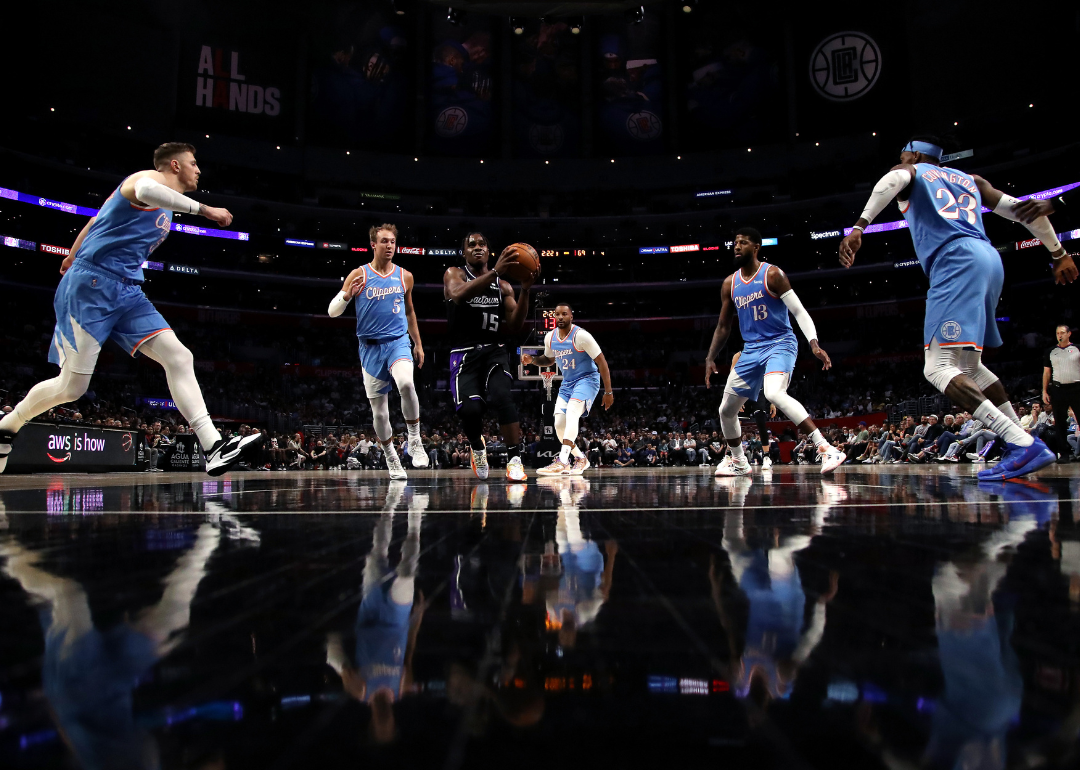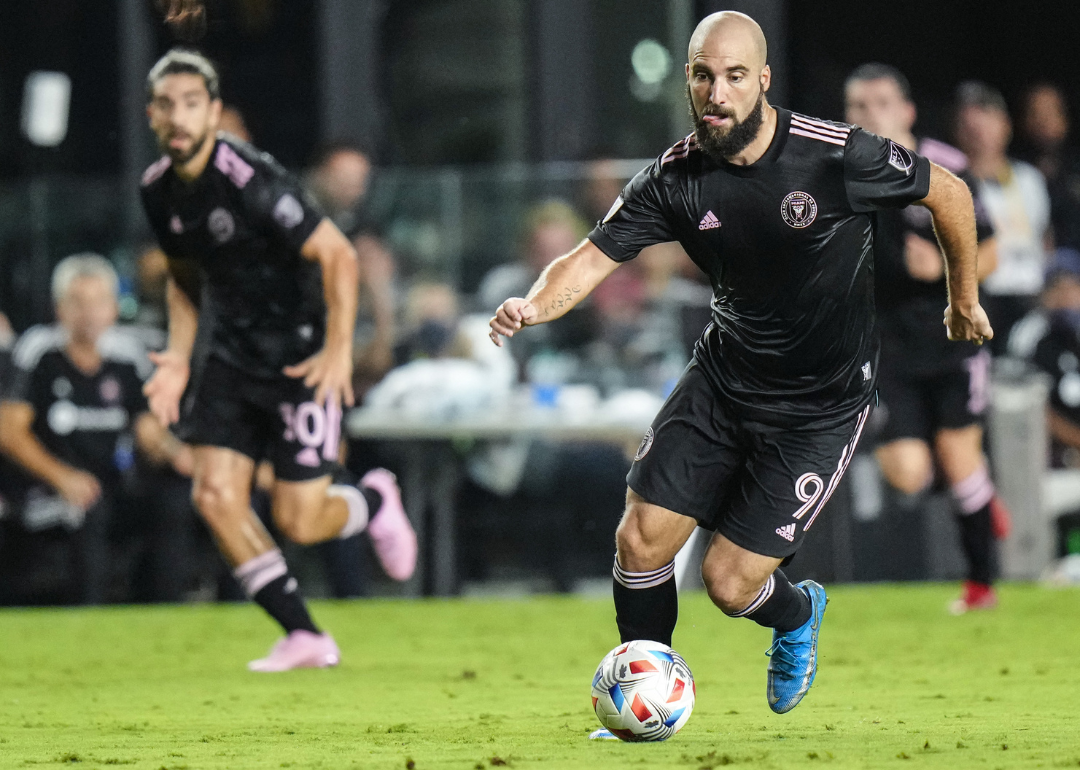Here’s how 4 of the newest, billion-dollar sports stadiums are being funded

Gary Coronado / Los Angeles Times via Getty Images
Here’s how 4 of the newest, billion-dollar sports stadiums are being funded
The Intuit Dome Steel Topping Out, the biggest construction milestone in the building of the LA Clippers new arena, on Tuesday, March 7, 2023 in Inglewood, CA.
For generations, professional stadiums and arenas in the United States relied heavily on public funding from taxpayers. The arms race between teams to build the best venues has escalated at a dizzying pace in the past twenty years. For perspective, new stadiums have become the trend for the NFL. Of the 32 current franchises in the NFL, 19 have opened the doors on a new stadium since 2000.
For the Cincinnati Bengals, the cost of opening Paul Brown Stadium (now Paycor Stadium) in 2000 was $455 million, which when adjusted for inflation, is just over $773 million in 2023 dollars. The new SoFi Stadium in Los Angeles, which plays home to the Chargers and Rams, had an inflation-adjusted price tag of $5.65 billion. So who is financing these gargantuan price tags? OLBG has researched local government websites and other sources to find out.
When it’s an NFL team breaking ground on a new stadium deal, it’s often the public that is picking up a portion of the costly bill. But over time, state legislatures, governors and the taxpaying public have become weary of de facto blank checks in the hands of NFL owners. As a result, state funding to partially fund these stadium projects has shrunk and contractual state benefits have increased.
The current landscape of professional stadium and arena projects is littered with proposals, partial approvals and stalled efforts. But as of today, four major projects have received green lights across the NFL, the NBA and the MLS. All four of the projects have price tags exceeding one billion dollars, but the specifics are considerably different. OLBG took a look at what it costs to build these glimmering palaces and what residents can expect in return.
![]()

Timothy T Ludwig // Getty Images
NFL: Buffalo Bills
Tremaine Edmunds #49 of the Buffalo Bills celebrates after an interception during a game against the New England Patriots at Highmark Stadium on January 08, 2023.
Total cost: $1.4 billion (Groundbreaking spring 2023, to open in 2026)
State Cost: $600 million from New York, $250 million From Erie County
State Benefits: The creation of 10,000 union jobs
The Buffalo Bills have played in Orchard Park, New York at their current site since 1973. When they opened the stadium doors fifty years ago, the venue was known as Rich Stadium. Rich Products, a Buffalo-based food products company, signed a 25-year, $1.5 million deal for naming rights. When that deal expired in 1998, it became the Ralph Wilson Stadium, named after the Bills’ then-owner. In 2016, New Era Field became the venue’s third name after New Era Cap Company and the Bills reached a seven-year, $35 million naming agreement. In 2021, it was called Highmark Stadium after Highmark Blue Cross Blue Shield of Western New York signed a 10-year naming agreement.
The Bills’ home is the fourth-oldest venue in the NFL and has been at the heart of relocation rumors for decades. Gov. Kathy Hochul made it a priority to broker a new stadium deal that would keep the Bills in Western New York for the foreseeable future. As a result, the public/private partnership covers the $1.4 billion dollar deal. New York is covering $600 million (42.9%), Erie County is pitching in $250 million (17.1%) and the NFL and Bills are paying for the remaining $550 million.
It’s Gov. Hochul’s intention that the “economic and tax impacts generated from the team will support more than 100 percent of the public share of the new stadium cost.” In a press release, she is quoted as saying that this deal will ensure the Bills will stay in Buffalo for another 30 years and that “the project will create 10,000 union jobs.” Given that the Bills generate $27 million annually in direct income, sales and use taxes for New York, it’s fairly reasonable for the state to expect recouping its investment and more in the next three decades.

Ronald Martinez // Getty Images
NFL: Tennessee Titans
Kevin Byard #31 of the Tennessee Titans celebrates with teammates after an interception against the Los Angeles Chargers at SoFi stadium in 2022.
Total cost: $2.1 billion (Groundbreaking fall 2023, to open in 2026)
State Cost: $500 million
State Benefits: The Titans will make annual payments to the Nashville Needs Impact Fund over the term of the lease totaling at least $47 million. Funds will support nonprofits serving Nashville and Davidson County for public education, public transit, gender equity in sports and affordable housing.
The Tennessee Titans were the beneficiaries of a stadium deal gone bad back in the mid-1990s. The Houston Oilers, owned at the time by Bud Adams, wanted to replace the aging Astrodome. But just as he began pressuring local and state authorities for help on the deal, the Oilers fell apart on the field. Houston finished 12-4 as AFC Central champions in 1993, but won just two games the following season, finishing 2-14 on the year. That amounted to the biggest one-season regression in NFL history. As a result, Adams’ multipurpose downtown stadium proposal fell on deaf ears. So instead of forking out more cash to get it done, Adams moved the team to Nashville in 1997. Soon thereafter, Nissan Stadium construction began. And after one year in Memphis at the Liberty Bowl and the 1998 season at Vanderbilt’s home stadium, the Titans saw the Nissan Stadium open its doors.
While the location has suited the franchise, Nissan Stadium’s amenities and revenue opportunities haven’t aged well. A newly approved stadium, set to open in 2026, will be state of the art. The slightly smaller, weatherproofed stadium will have a translucent roof and terraces with panoramic views of the city.s.The location will also open up prime waterfront real estate opportunities for both the city and developers. The signed deal will also create a 12,000-square-foot community plaza adjacent to the stadium that will be used for “educational opportunities, non-profit events, and other community-minded purposes,” according to the Tennessee Titans.
Additional community benefits include a large payment from the franchise to the Nashville Needs Impact Fund. Over time the Titans will contribute $47 million to the fund, which will allow nonprofits serving Nashville and Davidson County to aid public education, public transit, gender equity in sports and affordable housing.
The NFL, the Titans and personal seat license (PSL) sales will cover at least $840 million for the construction cost overruns per their signed agreement. A PSL is essentially a premium price fans pay to secure a seat, granting them first access to that seat for any events the stadium will host. A one-time state contribution of $500 million is a part of the deal as well as $760 million coming from revenue bonds issued by the Metro Sports Authority. The $760 million will be repaid by revenue generated primarily by hotel visitors and new stadium guests. The new stadium’s location will also create value for the city according to its mayor, who sees opportunities for building more public parks, affordable housing, and a transit hub.

Katelyn Mulcahy // Getty Images
NBA: Los Angeles Clippers
Total cost: $2 billion (Groundbreaking fall 2021, to open in fall 2024)
State Cost: $0
State Benefits: A $100 milllion pledge by Clippers owner Steve Ballmer to invest in the city of Inglewood.
When Steve Ballmer bought the Clippers for $2 billion in 2014, he hoped to someday have their own arena. Sharing the floor with the world-famous Lakers at the Staples Center (now Crypto.com Arena) had a way of weakening the Clippers brand and Ballmer made it a goal to change that. Since he bought the team, its value has nearly doubled to $3.9 billion, according to Forbes. He’s also found a way to offset the $2 billion-dollar price tag on their soon-to-be new home. Instead of going to the state or local government, he’s negotiated a $500 million naming rights deal with Intuit.
With zero state or government liability, it’s understandable that his claims to inject $100 million into the city of Inglewood aren’t contractually obligated. What he has said on the record, however, is that $80 million will go toward affordable housing. According to ESPN, this will be “the largest commitment of funding for community programs made in connection to a sports or entertainment venue in California.” Another $12.75 million is rumored to go toward school and youth programs.
The stadium, which is set to open in time for the 2024-2025 NBA season, will feature basketball’s largest and most impressive LED display to date. This “Halo Board” will stretch nearly an acre, surrounding 18,000 fans with a 4K view of replays, individual stats, quarter breakdowns and advanced metrics, according to the Clippers.
Not only has Inglewood benefited from Ballmer’s ambition, but the city has proven to be very savvy in terms of its contracts, with the hopes of keeping as much of the prosperity in the southwestern LA neighborhood. According to the LA Times, when the city previously agreed to NFL’s SoFi stadium and other local construction projects, it included a 35% local-hire provisions in its agreements, which were designed toto provide 50,000 construction jobs. The local-hire figures are yet to be released for the Intuit Dome project, but if they were able to include similar requirements, even more economic development is on its way to Inglewood in the coming years.

Mark Brown // Getty Images
MLS: Inter Miami CF
Gonzalo Higuaín #9 of Inter Miami CF controls the ball against Chicago Fire FC during the second half at DRV PNK Stadium.
Total cost: $1 billion (Groundbreaking late 2023/early 2024, to open In 2025)
State Cost: $0
State Benefits: The venue would generate at least $2.67 billion in rent payments in Fort Lauderdale over the life of the lease, and create 15,000 jobs.
Another billion-dollar stadium is on the way without taxpayer money. This time it comes from the MLS, David Beckham and the Mas brothers. The franchise has made do at DRV PNK Stadium since 2020, but the $60 million, 18,000-seat venue is not what this ambitious team had in mind. Instead, they’ve spent the last few years lobbying the local government for an area to build their new venue. Instead of buying the land, they’ve negotiated a lease to build on 131acres of public land.
The project is multifaceted and allows the Fort Lauderdale area to collect at least $2.67 billion in rent payments to the city over the life of the lease. It will also create 15,000 jobs as not only will Inter Miami CF build a 25,000-seat stadium, but they’ll also develop one million square feet of office, retail and commercial space, along with 750 hotel rooms. An additional 23 acres will be used for public soccer fields and 58 acres will be sectioned off for a public park. Miami Freedom Park, as it will be known, will be controlled by Inter Miami for the next 99 years. In addition to the payment the franchise will make to the city, Inter Miami has pledged $20 million to Miami t for park improvements and a living wage for future workers at the location. In short, this has the potential to be the most impactful public/private partnership involving a sports venue in American history.
This story originally appeared on OLBG and has been independently reviewed to meet journalistic standards.